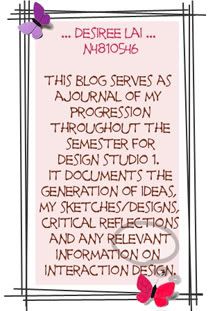

Tuesday, May 30, 2006
Critical Incident Analysis 2
- What exactly is "fun"?
Fun is defined as a source of enjoyment, amusement, or pleasure but I have come to realise that fun can be triggered by numerous factors. Koster (2004) stated that fun is a "constellation of different feelings" and the word "fun" is a very vague term.
Game designers have tried to dissect the word and come up with categories of fun. Hunicke, LeBlanc & Zubek (2004) defined eight types of fun:
1. Sensation - Game as sense-pleasure
2. Fantasy -Game as make-believe
3. Narrative - Game as drama
4. Challenge - Game as obstacle course
5. Fellowship - Game as social framework
6. Discovery - Game as uncharted territory
7. Expression - Game as self-discovery
8. Submission - Game as pastime
The founder and President of XEODesign, Inc, Nicole Lazzaro conducted studies on how people play games and why they play them. Lazzaro (2004) arrived at 4 groups of emotions of players brought upon by games are they are:
1. Hard Fun - Emotions from meaningful challenges, strategies, and puzzles
2. Easy Fun - Grabbing attention with ambiguity, incompleteness, and detail altered states
3. Altered states - Emotion generated with perception, thought, behavior, and other people
4. The People Factor - Opportunities created for player competition, cooperation, performance, and spectacle.
The above mentioned are what makes us feel good and I agreed with Koster's (2004) statement that "lumping them all together as "fun" just renders the word meaningless".
Simply knowing whether the game was enjoyable or not may be enough for some but that is a very superficial way of looking at it, especially in regards to game design. The experiences and reactions of players are generally unpredictable. Therefore, it is important for the developer to gain a deeper understanding as to exactly what the trigger was that led the player to believe that the game was fun. Considering the elements that will result in fun can help shed light on how and why certain games appeal to different players or to the same players at different times (Hunicke, LeBlanc & Zubek, 2004).
It is essential for one to understand games as dynamic systems as it helps us to develop techniques for iterative design and improvement (Hunicke, LeBlanc & Zubek, 2004). By understanding how the different types of fun and its triggers impact the user experience will allow me to design better interactive environments, not just games. It will also heavily influence the ways I conduct future research and criticism in relation to my designs.
References
Hunicke, R., LeBlanc, M. and Zubek, R. 2004. A Formal Approach to Game Design and Game Research http://www.cs.northwestern.edu/~hunicke/pubs/MDA.pdf (accessed May 25th 2006)
Koster, R. 2004. Book Excerpt: "A Theory of Fun for Game Design" - What Games Aren't. http://www.gamasutra.com/features/20041203/koster_01.shtml (accessed May 25th 2006)
Lazzaro, N. 2004. Why we play games: Four keys to more emotion without story.
http://xeodesign.com/xeodesign_whyweplaygames.pdf (accessed May 25th 2006)
unit links
- KIB210 OLT
- Jane Turner - Interaction
- Jane Turner - Lecture 8
- Jane Turner - Lecture 9
- Jane Turner - Class notes
useful transits
- Jens Jensen - Interactivity
- Fundamentals of Interactivity
- Writing a critique
- Jonas Lowgren - Sketching Interaction Design
- How to create a clear project plan
- Prototyping
- Usability methods
- A Theory of Fun for Game Design" - What Games Aren't
- Flash kit
- Ljudo.com - Sound effects database
- Sounddogs - Sound effects database
- Critical Incident Technique Analysis
- Gamasutra